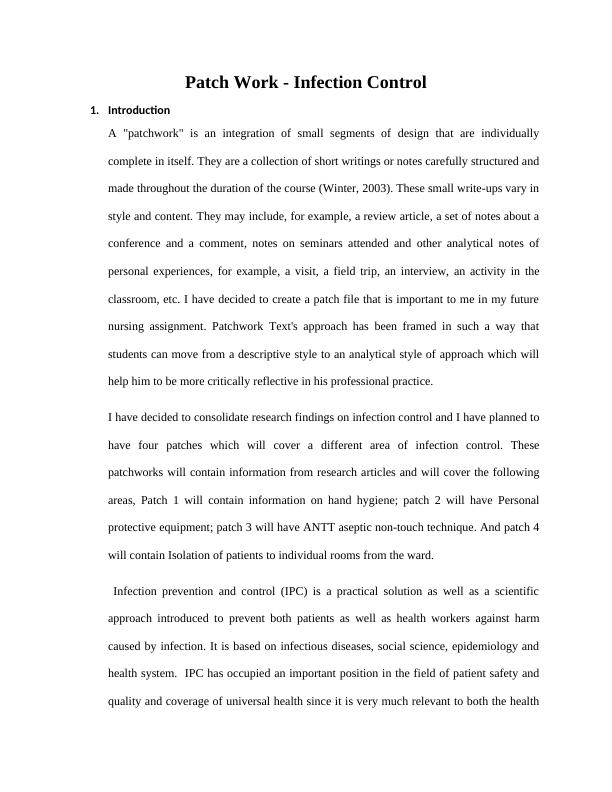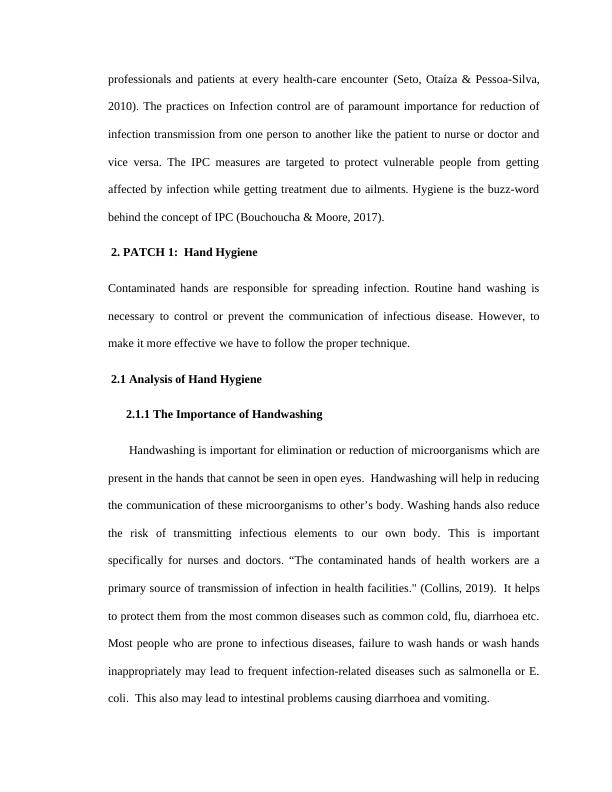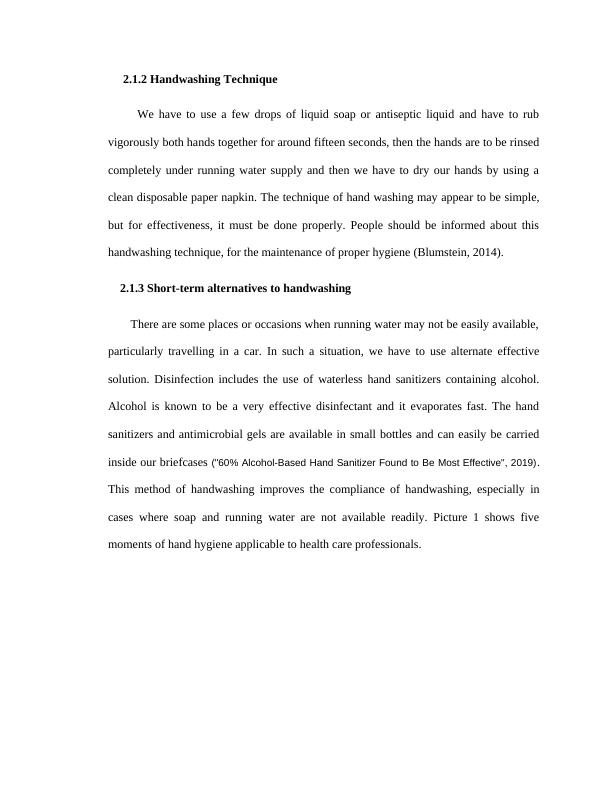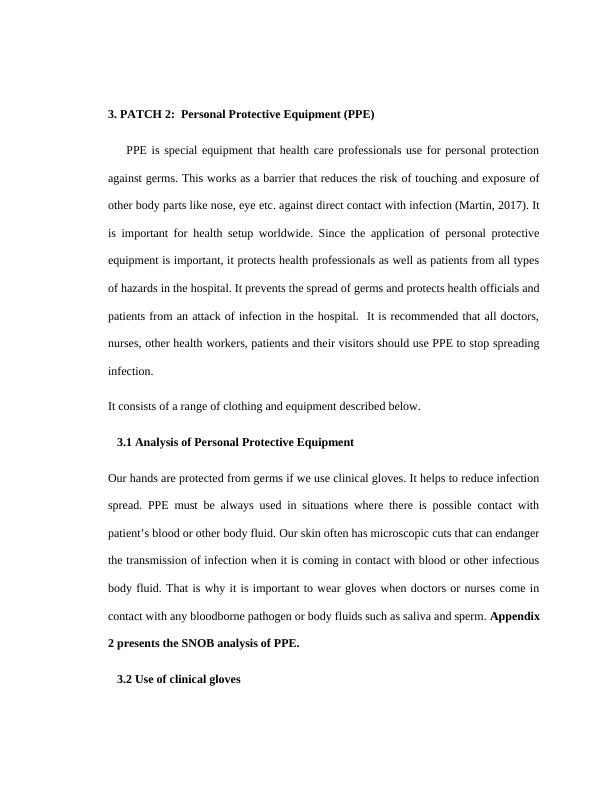Patch Work - Infection Control
Submit a 3,500 word Patchwork Text that demonstrates your learning journey and personal engagement with the education programme.
23 Pages5679 Words483 Views
Added on 2023-04-19
About This Document
This document discusses the concept of patchwork in infection control, focusing on hand hygiene, personal protective equipment (PPE), and ANTT aseptic non-touch technique. It provides an analysis of the importance of handwashing, proper handwashing technique, and the use of different types of PPE. The document also explains the key concepts of ANTT aseptic non-touch technique and its application in healthcare settings.
Patch Work - Infection Control
Submit a 3,500 word Patchwork Text that demonstrates your learning journey and personal engagement with the education programme.
Added on 2023-04-19
ShareRelated Documents
Patch Work - Infection Control
1. Introduction
A "patchwork" is an integration of small segments of design that are individually
complete in itself. They are a collection of short writings or notes carefully structured and
made throughout the duration of the course (Winter, 2003). These small write-ups vary in
style and content. They may include, for example, a review article, a set of notes about a
conference and a comment, notes on seminars attended and other analytical notes of
personal experiences, for example, a visit, a field trip, an interview, an activity in the
classroom, etc. I have decided to create a patch file that is important to me in my future
nursing assignment. Patchwork Text's approach has been framed in such a way that
students can move from a descriptive style to an analytical style of approach which will
help him to be more critically reflective in his professional practice.
I have decided to consolidate research findings on infection control and I have planned to
have four patches which will cover a different area of infection control. These
patchworks will contain information from research articles and will cover the following
areas, Patch 1 will contain information on hand hygiene; patch 2 will have Personal
protective equipment; patch 3 will have ANTT aseptic non-touch technique. And patch 4
will contain Isolation of patients to individual rooms from the ward.
Infection prevention and control (IPC) is a practical solution as well as a scientific
approach introduced to prevent both patients as well as health workers against harm
caused by infection. It is based on infectious diseases, social science, epidemiology and
health system. IPC has occupied an important position in the field of patient safety and
quality and coverage of universal health since it is very much relevant to both the health
1. Introduction
A "patchwork" is an integration of small segments of design that are individually
complete in itself. They are a collection of short writings or notes carefully structured and
made throughout the duration of the course (Winter, 2003). These small write-ups vary in
style and content. They may include, for example, a review article, a set of notes about a
conference and a comment, notes on seminars attended and other analytical notes of
personal experiences, for example, a visit, a field trip, an interview, an activity in the
classroom, etc. I have decided to create a patch file that is important to me in my future
nursing assignment. Patchwork Text's approach has been framed in such a way that
students can move from a descriptive style to an analytical style of approach which will
help him to be more critically reflective in his professional practice.
I have decided to consolidate research findings on infection control and I have planned to
have four patches which will cover a different area of infection control. These
patchworks will contain information from research articles and will cover the following
areas, Patch 1 will contain information on hand hygiene; patch 2 will have Personal
protective equipment; patch 3 will have ANTT aseptic non-touch technique. And patch 4
will contain Isolation of patients to individual rooms from the ward.
Infection prevention and control (IPC) is a practical solution as well as a scientific
approach introduced to prevent both patients as well as health workers against harm
caused by infection. It is based on infectious diseases, social science, epidemiology and
health system. IPC has occupied an important position in the field of patient safety and
quality and coverage of universal health since it is very much relevant to both the health

professionals and patients at every health-care encounter (Seto, Otaíza & Pessoa-Silva,
2010). The practices on Infection control are of paramount importance for reduction of
infection transmission from one person to another like the patient to nurse or doctor and
vice versa. The IPC measures are targeted to protect vulnerable people from getting
affected by infection while getting treatment due to ailments. Hygiene is the buzz-word
behind the concept of IPC (Bouchoucha & Moore, 2017).
2. PATCH 1: Hand Hygiene
Contaminated hands are responsible for spreading infection. Routine hand washing is
necessary to control or prevent the communication of infectious disease. However, to
make it more effective we have to follow the proper technique.
2.1 Analysis of Hand Hygiene
2.1.1 The Importance of Handwashing
Handwashing is important for elimination or reduction of microorganisms which are
present in the hands that cannot be seen in open eyes. Handwashing will help in reducing
the communication of these microorganisms to other’s body. Washing hands also reduce
the risk of transmitting infectious elements to our own body. This is important
specifically for nurses and doctors. “The contaminated hands of health workers are a
primary source of transmission of infection in health facilities." (Collins, 2019). It helps
to protect them from the most common diseases such as common cold, flu, diarrhoea etc.
Most people who are prone to infectious diseases, failure to wash hands or wash hands
inappropriately may lead to frequent infection-related diseases such as salmonella or E.
coli. This also may lead to intestinal problems causing diarrhoea and vomiting.
2010). The practices on Infection control are of paramount importance for reduction of
infection transmission from one person to another like the patient to nurse or doctor and
vice versa. The IPC measures are targeted to protect vulnerable people from getting
affected by infection while getting treatment due to ailments. Hygiene is the buzz-word
behind the concept of IPC (Bouchoucha & Moore, 2017).
2. PATCH 1: Hand Hygiene
Contaminated hands are responsible for spreading infection. Routine hand washing is
necessary to control or prevent the communication of infectious disease. However, to
make it more effective we have to follow the proper technique.
2.1 Analysis of Hand Hygiene
2.1.1 The Importance of Handwashing
Handwashing is important for elimination or reduction of microorganisms which are
present in the hands that cannot be seen in open eyes. Handwashing will help in reducing
the communication of these microorganisms to other’s body. Washing hands also reduce
the risk of transmitting infectious elements to our own body. This is important
specifically for nurses and doctors. “The contaminated hands of health workers are a
primary source of transmission of infection in health facilities." (Collins, 2019). It helps
to protect them from the most common diseases such as common cold, flu, diarrhoea etc.
Most people who are prone to infectious diseases, failure to wash hands or wash hands
inappropriately may lead to frequent infection-related diseases such as salmonella or E.
coli. This also may lead to intestinal problems causing diarrhoea and vomiting.

2.1.2 Handwashing Technique
We have to use a few drops of liquid soap or antiseptic liquid and have to rub
vigorously both hands together for around fifteen seconds, then the hands are to be rinsed
completely under running water supply and then we have to dry our hands by using a
clean disposable paper napkin. The technique of hand washing may appear to be simple,
but for effectiveness, it must be done properly. People should be informed about this
handwashing technique, for the maintenance of proper hygiene (Blumstein, 2014).
2.1.3 Short-term alternatives to handwashing
There are some places or occasions when running water may not be easily available,
particularly travelling in a car. In such a situation, we have to use alternate effective
solution. Disinfection includes the use of waterless hand sanitizers containing alcohol.
Alcohol is known to be a very effective disinfectant and it evaporates fast. The hand
sanitizers and antimicrobial gels are available in small bottles and can easily be carried
inside our briefcases ("60% Alcohol-Based Hand Sanitizer Found to Be Most Effective", 2019).
This method of handwashing improves the compliance of handwashing, especially in
cases where soap and running water are not available readily. Picture 1 shows five
moments of hand hygiene applicable to health care professionals.
We have to use a few drops of liquid soap or antiseptic liquid and have to rub
vigorously both hands together for around fifteen seconds, then the hands are to be rinsed
completely under running water supply and then we have to dry our hands by using a
clean disposable paper napkin. The technique of hand washing may appear to be simple,
but for effectiveness, it must be done properly. People should be informed about this
handwashing technique, for the maintenance of proper hygiene (Blumstein, 2014).
2.1.3 Short-term alternatives to handwashing
There are some places or occasions when running water may not be easily available,
particularly travelling in a car. In such a situation, we have to use alternate effective
solution. Disinfection includes the use of waterless hand sanitizers containing alcohol.
Alcohol is known to be a very effective disinfectant and it evaporates fast. The hand
sanitizers and antimicrobial gels are available in small bottles and can easily be carried
inside our briefcases ("60% Alcohol-Based Hand Sanitizer Found to Be Most Effective", 2019).
This method of handwashing improves the compliance of handwashing, especially in
cases where soap and running water are not available readily. Picture 1 shows five
moments of hand hygiene applicable to health care professionals.

Picture 1 showing 5 moments for hand hygiene for health care workers
2.1.4 Promote hand hygiene
First, we have to analyze the reasons why hand hygiene guidelines are not followed,
particularly regarding hand washing. The reasons generally cited are that people are too
busy with work-load at their place of work and find it inconvenient to wash hands before
any new activity (Barrett & Randle, 2008). This is particularly observed among health
care professionals who should actually follow the guidelines in letter and spirit. Some of
the efforts that may be attempted to improve compliance include appropriate education
on infection control, visual advertisements using different media for promotion of good
hand hygiene, well-located equipment with disinfectants for hand wash and spreading the
message to all via television, radio or social media by the government health
departments. Proper hand hygiene can prevent the transmission of nosocomial infections.
Health care workers should not only wash their hands properly but also guide patients
and their visitors to do the same to continue the infection control process.
2.1.4 Promote hand hygiene
First, we have to analyze the reasons why hand hygiene guidelines are not followed,
particularly regarding hand washing. The reasons generally cited are that people are too
busy with work-load at their place of work and find it inconvenient to wash hands before
any new activity (Barrett & Randle, 2008). This is particularly observed among health
care professionals who should actually follow the guidelines in letter and spirit. Some of
the efforts that may be attempted to improve compliance include appropriate education
on infection control, visual advertisements using different media for promotion of good
hand hygiene, well-located equipment with disinfectants for hand wash and spreading the
message to all via television, radio or social media by the government health
departments. Proper hand hygiene can prevent the transmission of nosocomial infections.
Health care workers should not only wash their hands properly but also guide patients
and their visitors to do the same to continue the infection control process.

Handwashing is not just like a routine activity, it is related to our personal hygiene
and it is one of a most effective way to control the spread of infection from one person to
another. Though it looks simple but is highly effective in controlling the spread of disease
fast. Hands must be washed before and after meals, when they visibly look dirty or
contaminated, after using the toilet, after contact with animals or contact with other
persons by handshaking etc. We should essentially wash or hands after coming back from
a hospital or nursing home.
We have to follow these guidelines if we want to keep ourselves and others
surrounding us fit. We should always remember that if we use gloves it does not
eliminate the need to wash our hands. Hand wash is having different purpose and gloves
are having some other purpose which I am going to discuss in the next patch. Gloves just
protect our hand from direct contact with an object but cannot protect our hands totally
against infection. It is recommended that we should make a habit to wash hands after
finishing any outdoor or indoor activity and before and after our daily meals. Annexure 1
covers SNOB 1.
2.1.5 Analysis on hand hygiene.
Although the hand hygiene procedure is simple, compliance among health care
workers including nurses is so low that it cannot be easily explained or changed. A
number of studies pointed out that this is due to lack of motivation and increased
workload of health care workers for poor compliance. Since they have to guide the
patients to follow this basic and they should prefer to protect themselves to a greater
extent than the patients (Karaaslan et al., 2014).
and it is one of a most effective way to control the spread of infection from one person to
another. Though it looks simple but is highly effective in controlling the spread of disease
fast. Hands must be washed before and after meals, when they visibly look dirty or
contaminated, after using the toilet, after contact with animals or contact with other
persons by handshaking etc. We should essentially wash or hands after coming back from
a hospital or nursing home.
We have to follow these guidelines if we want to keep ourselves and others
surrounding us fit. We should always remember that if we use gloves it does not
eliminate the need to wash our hands. Hand wash is having different purpose and gloves
are having some other purpose which I am going to discuss in the next patch. Gloves just
protect our hand from direct contact with an object but cannot protect our hands totally
against infection. It is recommended that we should make a habit to wash hands after
finishing any outdoor or indoor activity and before and after our daily meals. Annexure 1
covers SNOB 1.
2.1.5 Analysis on hand hygiene.
Although the hand hygiene procedure is simple, compliance among health care
workers including nurses is so low that it cannot be easily explained or changed. A
number of studies pointed out that this is due to lack of motivation and increased
workload of health care workers for poor compliance. Since they have to guide the
patients to follow this basic and they should prefer to protect themselves to a greater
extent than the patients (Karaaslan et al., 2014).

3. PATCH 2: Personal Protective Equipment (PPE)
PPE is special equipment that health care professionals use for personal protection
against germs. This works as a barrier that reduces the risk of touching and exposure of
other body parts like nose, eye etc. against direct contact with infection (Martin, 2017). It
is important for health setup worldwide. Since the application of personal protective
equipment is important, it protects health professionals as well as patients from all types
of hazards in the hospital. It prevents the spread of germs and protects health officials and
patients from an attack of infection in the hospital. It is recommended that all doctors,
nurses, other health workers, patients and their visitors should use PPE to stop spreading
infection.
It consists of a range of clothing and equipment described below.
3.1 Analysis of Personal Protective Equipment
Our hands are protected from germs if we use clinical gloves. It helps to reduce infection
spread. PPE must be always used in situations where there is possible contact with
patient’s blood or other body fluid. Our skin often has microscopic cuts that can endanger
the transmission of infection when it is coming in contact with blood or other infectious
body fluid. That is why it is important to wear gloves when doctors or nurses come in
contact with any bloodborne pathogen or body fluids such as saliva and sperm. Appendix
2 presents the SNOB analysis of PPE.
3.2 Use of clinical gloves
PPE is special equipment that health care professionals use for personal protection
against germs. This works as a barrier that reduces the risk of touching and exposure of
other body parts like nose, eye etc. against direct contact with infection (Martin, 2017). It
is important for health setup worldwide. Since the application of personal protective
equipment is important, it protects health professionals as well as patients from all types
of hazards in the hospital. It prevents the spread of germs and protects health officials and
patients from an attack of infection in the hospital. It is recommended that all doctors,
nurses, other health workers, patients and their visitors should use PPE to stop spreading
infection.
It consists of a range of clothing and equipment described below.
3.1 Analysis of Personal Protective Equipment
Our hands are protected from germs if we use clinical gloves. It helps to reduce infection
spread. PPE must be always used in situations where there is possible contact with
patient’s blood or other body fluid. Our skin often has microscopic cuts that can endanger
the transmission of infection when it is coming in contact with blood or other infectious
body fluid. That is why it is important to wear gloves when doctors or nurses come in
contact with any bloodborne pathogen or body fluids such as saliva and sperm. Appendix
2 presents the SNOB analysis of PPE.
3.2 Use of clinical gloves

End of preview
Want to access all the pages? Upload your documents or become a member.
Related Documents
Hand Washing Among Health Care Professionals Case Study 2022lg...
|4
|1075
|33
Effect of Handwashing Techniques on Hospital-Acquired Infectionslg...
|5
|1074
|1
Methods of preventing cross infectionlg...
|8
|1245
|75
Assignment on Cross Infection pdflg...
|10
|2252
|61
Preventing Cross Infection in Dental Settingslg...
|16
|4316
|388
Role of Education in preventing Infection Essaylg...
|4
|854
|616
